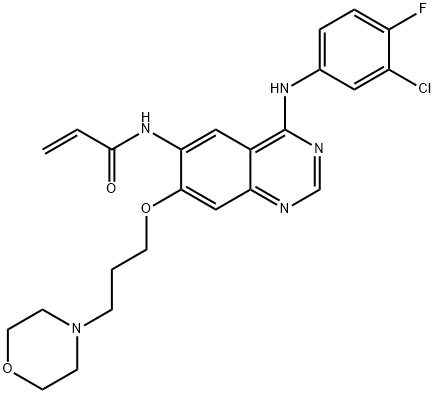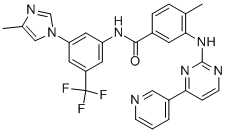LFM-A13
- CAS NO.:244240-24-2
- Empirical Formula: C11H8Br2N2O2
- Molecular Weight: 360
- MDL number: MFCD09878279
- SAFETY DATA SHEET (SDS)
- Update Date: 2024-11-19 23:02:33

What is LFM-A13?
Description
LFM-A13 (244240-24-2) is a selective inhibitor of Bruton’s tyrosine kinase (BTK) – IC50‘s = 2.5 μM (recombinant BTK) and 17.2 μM (human BTK).1,2 It has also been shown to inhibit Polo-like kinase (PLK) – IC50 = 61 μM for human PLK3.3 LFM-A13 displayed no activity (concentrations up to 278 μM) at JAK1, JAK3, HCK, EGFRK and IRK2 or CDK1-3, CHK1, IKK, MAPK1, SAPK2a and ten other tyrosine kinases.3
The Uses of LFM-A13
LFM-A13 is a potent inhibitor of Polo-like kinase (PLK), used for anti-breast cancer activity. Also a specific Bruton’s tyrosine kinase inhibitor.
in vitro
lfm-a13 inhibited recombinant btk expressed in a baculovirus expression vector system. besides its remarkable potency in btk kinase assays, lfm-a13 was also found to be a highly specific inhibitor of btk. even at very high concentrations, lfm-a13 did not affect the activity of other protein tyrosine kinases [1].
in vivo
lfm-a13 exhibited a favorable pharmacokinetic behavior which was not adversely affected by the standard chemotherapy drugs and significantly improved the chemotherapy response and survival outcome of bcl-1 leukemia cells challenged mice. while only 14% of mice treated with the standard triple-drug combination treatment became long-term survivors, 41% of mice treated with this combination plus lfm-a13 survived long-term [2].
References
1) Vassilev et al. (1999), Bruton’s tyrosine kinase as an inhibitor of the Fas/CD95 death-inducing signaling complex; J. Biol. Chem., 274 1646 2) Mahajan et al. (1999), Rational design and synthesis of a novel-anti-leukemic agent targeting Bruton’s tyrosine kinase (BTK), LFM-A13 [α-cyano-β-hydroxy-β-methyl-N-(2,5-dibromophenyl)propenamide]; J. Biol. Chem. 274 9587 3) Uckun et al. (2007) Anti-breast cancer activity of LFM-A13, a potent inhibitor of polo-like kinase (PLK); Bioorg. Med. Chem. 15 800
Properties of LFM-A13
| Melting point: | 150-151 °C |
| Boiling point: | 487.9±45.0 °C(Predicted) |
| Density | 1.909±0.06 g/cm3(Predicted) |
| storage temp. | −20°C |
| solubility | DMSO: 15 mg/mL |
| pka | 5.20±0.50(Predicted) |
| form | powder |
| color | white |
| Stability: | Stable for 2 years from date of purchase as supplied. PROTECT FROM MOISTURE. Solutions in DMSO or ethanol may be stored at -20°C for up to 3 months. |
Safety information for LFM-A13
| Signal word | Warning |
| Pictogram(s) |
 Exclamation Mark Irritant GHS07 |
| Precautionary Statement Codes |
P261:Avoid breathing dust/fume/gas/mist/vapours/spray. P264:Wash hands thoroughly after handling. P264:Wash skin thouroughly after handling. P280:Wear protective gloves/protective clothing/eye protection/face protection. P301+P312:IF SWALLOWED: call a POISON CENTER or doctor/physician IF you feel unwell. |
Computed Descriptors for LFM-A13
New Products
Tert-butyl bis(2-chloroethyl)carbamate 4-Methylphenylacetic acid N-Boc-D-alaninol N-BOC-D/L-ALANINOL N-octanoyl benzotriazole 3-Morpholino-1-(4-nitrophenyl)-5,6-dihydropyridin- 2(1H)-one Furan-2,5-Dicarboxylic Acid DIETHYL AMINOMALONATE HYDROCHLORIDE 1,1’-CARBONYLDIIMIDAZOLE R-2-BENZYLOXY PROPIONIC ACID 1,1’-CARBONYLDI (1,2-4 TRIAZOLE) N-METHYL INDAZOLE-3-CARBOXYLIC ACID (2-Hydroxyphenyl)acetonitrile 4-Bromopyrazole 5-BROMO-2CYANO PYRIDINE 5,6-Dimethoxyindanone 5-broMo-2-chloro-N-cyclopentylpyriMidin-4-aMine 2-(Cyanocyclohexyl)acetic acid 4-methoxy-3,5-dinitropyridine 1-(4-(aminomethyl)benzyl)urea hydrochloride 2-aminopropyl benzoate hydrochloride diethyl 2-(2-((tertbutoxycarbonyl)amino) ethyl)malonate tert-butyl 4- (ureidomethyl)benzylcarbamate Ethyl-2-chloro((4-methoxyphenyl)hydrazono)acetateRelated products of tetrahydrofuran








You may like
-
 LFM-A13 CAS 244240-24-2View Details
LFM-A13 CAS 244240-24-2View Details
244240-24-2 -
 1975-50-4 98%View Details
1975-50-4 98%View Details
1975-50-4 -
 2-HYDROXY BENZYL ALCOHOL 98%View Details
2-HYDROXY BENZYL ALCOHOL 98%View Details
90-01-7 -
 2-Chloro-1,3-Bis(Dimethylamino)Trimethinium Hexafluorophosphate 221615-75-4 98%View Details
2-Chloro-1,3-Bis(Dimethylamino)Trimethinium Hexafluorophosphate 221615-75-4 98%View Details
221615-75-4 -
 61397-56-6 CIS BROMO BENZOATE 98%View Details
61397-56-6 CIS BROMO BENZOATE 98%View Details
61397-56-6 -
 14714-50-2 (2-Hydroxyphenyl)acetonitrile 98+View Details
14714-50-2 (2-Hydroxyphenyl)acetonitrile 98+View Details
14714-50-2 -
 118753-70-1 98+View Details
118753-70-1 98+View Details
118753-70-1 -
 733039-20-8 5-broMo-2-chloro-N-cyclopentylpyriMidin-4-aMine 98+View Details
733039-20-8 5-broMo-2-chloro-N-cyclopentylpyriMidin-4-aMine 98+View Details
733039-20-8